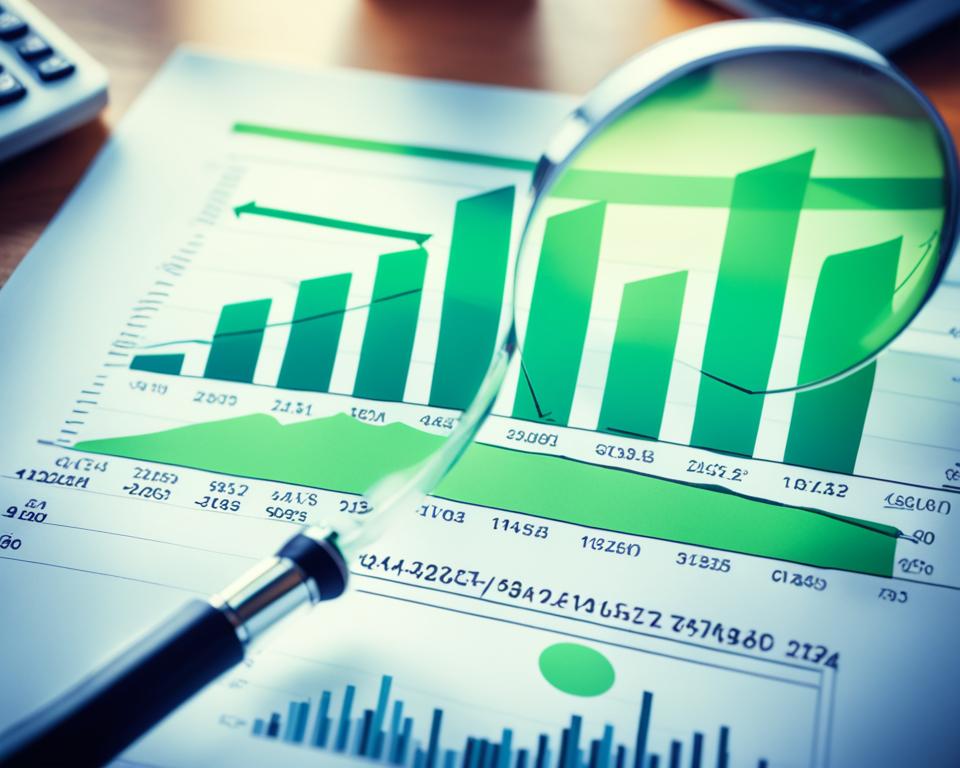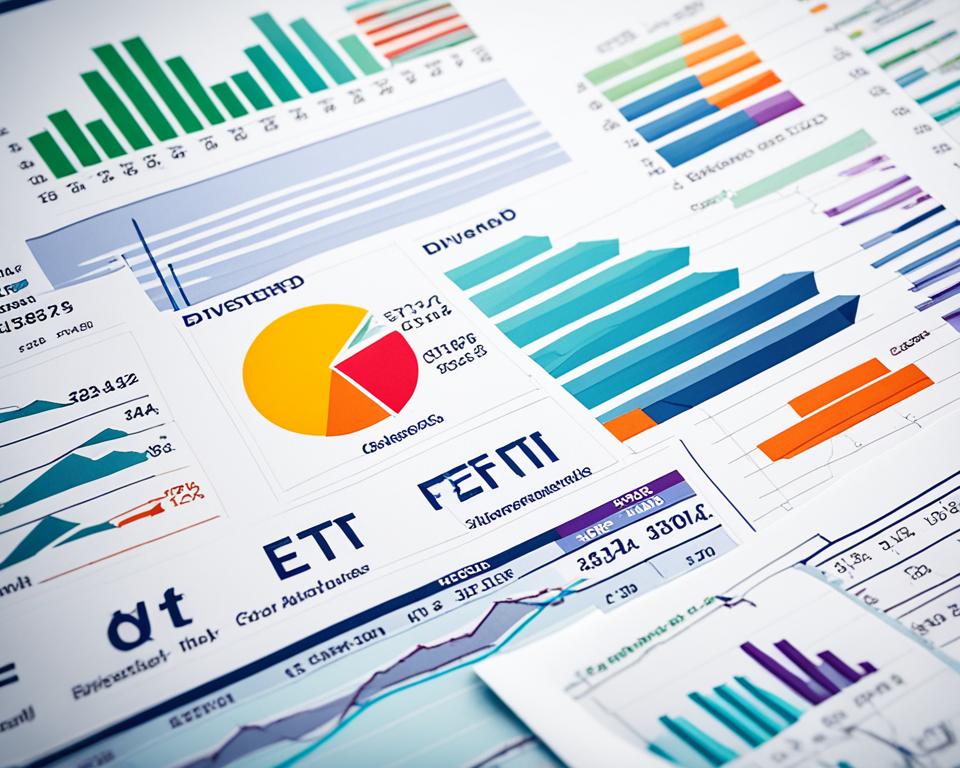When you’re analyzing dividend growth patterns, you’re unlocking a critical aspect of smart investing. Dividend growth analysis not only informs you about a company’s past performance but also serves as a compass directing towards its financial stability and long-term profitability. By interpreting dividend growth data, you gain invaluable insights into trends in dividend growth, which have the power to suggest the future trajectory of stock performance.
Understanding the subtleties of this growth—how dividends have increased over time, the steadiness of this trend, and the potential for its continuity—can provide you with a more profound understanding of a company’s health. It’s like getting a sneak peek into the company’s boardroom, where decisions on profit-sharing with shareholders like you are being made. Armed with this knowledge, your investment choices gain depth and your portfolio, a more robust foundation.
Key Takeaways
- Interpreting dividend growth data provides a preview into a company’s future financial health.
- Analyzing dividend growth patterns is crucial for applying stock valuation models like the DDM.
- Investors can forecast long-term profitability by understanding trends in dividend growth.
- Dividend growth rates are pivotal for investors seeking to make informed stock purchases.
- Consistent dividend growth could signal a company’s enduring market strength and shareholder commitment.
The Importance of Assessing Dividend Growth Trends
As an investor, understanding and interpreting dividend growth data are essential steps towards ensuring the health and long-term profitability of your portfolio. This process involves analyzing the patterns and sustainability of a company’s dividends over time, which can offer insights into its financial strength and operational efficiency.
Understanding the Dividend Growth Rate
The dividend growth rate acts as a barometer, measuring the annualized percentage increase of a company’s dividend payouts over a specific timeframe. This rate is not just a historical record; it’s a critical component in stock valuation models, including the dividend discount model (DDM). By looking at how dividends have increased over the years, you gain perspective on the company’s commitment to returning value to shareholders.
Implications for Long-Term Stock Valuation
The strategic interpretation of dividend growth rates feeds directly into evaluating a stock’s intrinsic worth. Accurate calculations of these rates are indispensable for employing various stock valuation models. When intrinsic values, derived from models like DDM, are higher than market prices, stocks might be considered undervalued—a prospective opportunity for investors like you.
Dividend Growth as an Indicator of Company Health
Analysis of dividend trends goes beyond mere numbers; it’s a reflection of a company’s underlying strength and stability. A track record of rising dividend payouts is often synonymous with corporate resilience and ongoing success. This consistent dividend growth can be one of the most telling indicators of a business’s ability to maintain and enhance stockholder wealth over time.
Unearthing the Fundamentals of Dividends
At the heart of dividend growth analysis is a core understanding of what dividends are and why they hold such importance for investors. Dividends are not just rewards or bonuses; they embody a company’s ability to generate earnings and share the profits with its shareholders. Unlocking the intrinsic value of a company begins with comprehending this fundamental concept that lies at the cornerstone of equity investments and shareholder value.
What Constitutes a Dividend?
Imagine a slice of the profit pie being served directly to you—that slice is your dividend. Representing a portion of a company’s earnings, dividends are typically distributed among shareholders as a direct income stream. Their regularity and growth can be reflective of the company’s success and financial health. For you, as an investor, dividends not only mean potential routine income but also reassurance that the company you’ve vested interest in is thriving and acknowledging your stake in its journey.
Why Dividends Matter to Investors
Now, why should you, the astute investor, care about dividends? Dividends matter—and matter deeply—because they can be seen as a testament to a company’s stability and a signal of management’s confidence in the firm’s future. Besides serving as a gauge of predictable financial income, dividends have a significant impact on the value assessment of a company through vehicles like the dividend discount model or DDM. When you’re understanding dividend growth rates, you’re positioning yourself to navigate through the ebbs and flows of market volatility with a potent tool for equity valuation in your kit. Regular dividends can bolster your portfolio, especially when stock prices might be experiencing less motion, highlighting the perpetual significance of getting the dividend analysis right in your investment decisions.
Interpreting Dividend Growth Data for Investment Decisions
As you delve into the realm of investment, a keen eye on dividend growth data can elucidate a wealth of information about a company’s fiscal health and future prospects. To adeptly navigate the investment waters, let’s examine how interpreting dividend growth data can solidify your financial decisions and help you sail towards prosperity.
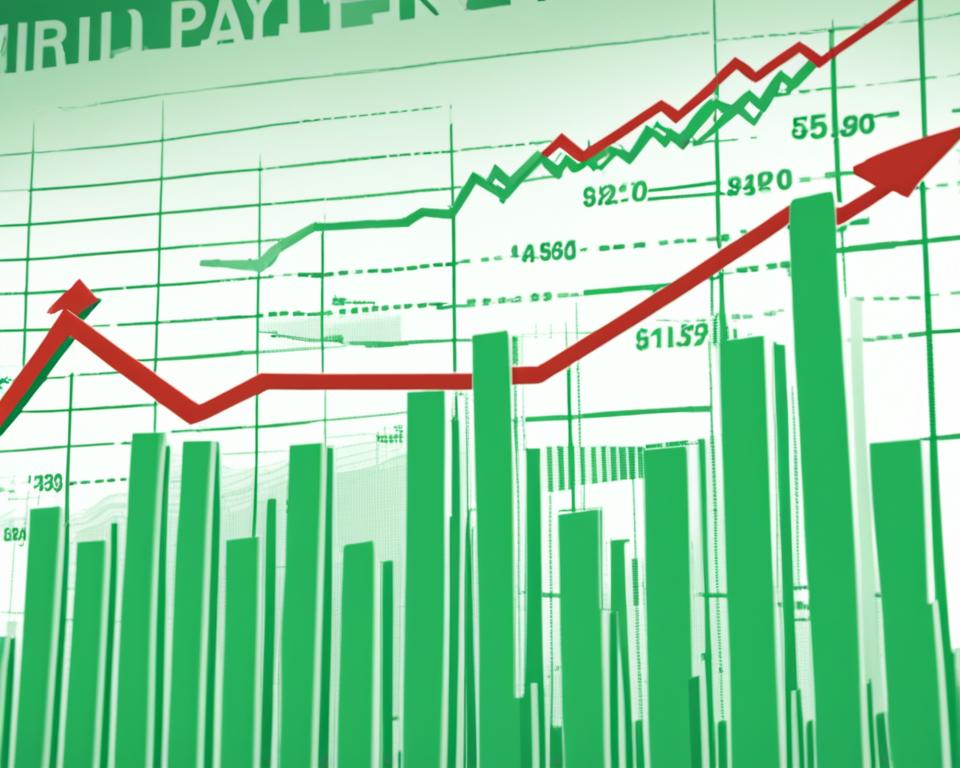
When you look at a company’s history of dividends, you’re peering through time to discern patterns that will likely continue. It’s akin to understanding the roots of a tree to predict how its branches will grow. The performance history of dividends, seen through their growth rates, offers a storytelling framework of a company’s commitment to its shareholders.
Using Historical Dividend Data to Project Future Trends
It’s not just about where the company has been, but also where it’s heading. The footsteps of past dividend behaviors pave the way for future growth expectations. Like analyzing a trail of breadcrumbs, examining historical increments in dividend payments allows you to foretell the possible paths a company’s profitability might take. This insight furthers your ability to make analyzing dividend growth patterns a cornerstone of your investment strategy.
How Dividend Trends Influence Stock Analysis
Understanding and leveraging the narrative that dividend patterns weave is instrumental in shaping stock analysis. A company that showcases a sturdy trend of escalating dividends may hint at solid future performances. On the other hand, flatlining or erratic dividends could be revealing underlying instabilities. The astute investor must learn to read these patterns—not simply as isolated financial events but as a fluent language of economic vitality and managerial strategies that influence stock valuation and the broader investment landscape.
Now, let’s look at how consistent, year-over-year increases in dividends reflect a company’s financial narrative:
| Year | Dividend Per Share | Year-Over-Year Growth |
|---|---|---|
| Year 1 | $1.00 | N/A |
| Year 2 | $1.05 | 5% |
| Year 3 | $1.07 | 1.9% |
| Year 4 | $1.11 | 3.74% |
| Year 5 | $1.15 | 3.6% |
The information derived from these dividend increments is a pivotal asset in your investment arsenal, shaping the strategies that ensure the resilience and growth of your portfolio. In essence, by interpreting dividend growth data, you chart the course of your financial voyage on a graph that rises with each calculated decision you make.
Calculating the Dividend Growth Rate
As you explore the realms of investing, particularly in dividend-bearing stocks, mastering the art of calculating dividend growth rate becomes imperative. This rate is pivotal for investors forecasting dividend growth, projecting the future performance of their portfolio, and determining the fair value of a stock. Armed with historical data and the right formulas, you can develop a clear picture of a company’s prospects.
Both linear and geometric methods are used to calculate the dividend growth rate, each with its own merits. The choice of method can significantly impact your stock valuation and investment decisions. Let’s delve into the nuances of both methods to better equip you for the task of forecasting dividend growth.
Linear vs. Geometric Growth Calculations
The linear method is straightforward, evaluating the dividend increment from one year to the next. While simplicity is its advantage, this method does not account for the compounding effect—which may be addressed by the geometric calculation. The geometric method, often seen as the more precise alternative, uses a geometric average that acknowledges the compound nature of growth over multiple periods.
The Role of Dividend History in Forecasting Growth
Historical dividend data is not merely a record of past performance, but a tool for peering into a company’s future. By understanding and applying the average growth rate found in the historic dividends, you can make educated guesses about future increases. Analyzing this data helps you trace patterns and, potentially, the trajectory of dividend progression.
Consider the dividends of a hypothetical company over a five-year span:
| Year | Dividend Per Share | Growth Rate |
|---|---|---|
| Year 1 | $1.00 | N/A |
| Year 2 | $1.05 | 5% |
| Year 3 | $1.07 | 1.9% |
| Year 4 | $1.11 | 3.74% |
| Year 5 | $1.15 | 3.6% |
Calculating the average growth rate across these years guides you in estimating the company’s ability to increase its dividends and, in the same breath, speaks volumes about its financial health. Whether you’re a novice investor or a seasoned market player, understanding how to calculate and interpret dividend growth rate is a crucial aspect of a well-rounded investment strategy, ensuring you make informed decisions that align with your financial goals.
Assessing Dividend Sustainability and Growth Potential
When looking into potential investments, the savvy investor will prioritize assessing dividend sustainability and dividend growth potential. These elements are crucial for discerning a stock’s capacity to provide long-term returns and are telling indicators of the company’s financial well-being.
Factors Affecting Dividend Stability
The bedrock of robust investment strategies is often found in the ability to understand the numerous factors that uphold or undermine dividend stability. You—the investor—need to consider diverse dimensions such as operational efficiency, industry standing, and corporate earnings. Historical dividend patterns offer a tapestry of information displaying a company’s financial consistency and commitment to shareholder value.
How to Spot Unsustainable Dividend Growth
Ironing out the finesse in identifying unsustainable dividend growth requires a delicate balance of financial acumen and strategic foresight. To unravel the complexities of dividend payout trends, it’s crucial to analyze a company’s payout ratios, its sector’s prevailing winds, and the broader economic outlook that may influence future performance and stability.
Adjusting your investment gaze to include these perspectives ensures that you can spot warning signs. Instances such as unprecedented spikes in dividend growth that may not align with profit margins or earnings reports are such red flags. Scrutinizing these subtleties equips you with the knowledge to gauge the sustainability of a company’s dividend trajectory.
Analyzing Dividend Growth Patterns in Different Market Conditions
As an investor, it’s imperative to grasp how differing market conditions impact a company’s aptitude for dividend growth. When analyzing dividend growth patterns, one must meticulously consider the economic environment because factors such as recessions, industry shifts, and unforeseen events can reshape a company’s dividend policy and influence your perception of the stock’s worth and reliability. For instance, the COVID-19 pandemic sharply reminded us that even stalwart companies might need to reposition dividends to protect capital, signaling the necessity of vigilance in tracking these patterns.
What do you, as a shareholder, need to consider when assessing dividend growth sustainability under varying market conditions? Economic downturns may tighten corporate belts, necessitating dividend cuts. Conversely, robust market climates might lead to generous increases. Take a closer look:
| Market Condition | Impact on Dividend Policy | Investor Implication |
|---|---|---|
| Economic Expansion | Increased earnings may lead to rising dividends | Potential for higher income |
| Recession | Possible dividend stagnation or cuts | Need for cautious investment strategy |
| Industry Disruption | Dividends could be affected by changes in sector dynamics | Importance of sector-specific analysis |
| Global Crises | Dividend reductions may be necessary for financial resilience | Diversification to mitigate risks |
While historical analysis remains a foundational tool in understanding dividend behavior, adding the dimension of market condition analysis elevates your financial strategy. It helps you to adapt and realign your portfolio to maintain a steady flow of dividends during tumultuous times. Your portfolio’s resilience in extreme market swings largely depends on how well-prepared you are in analyzing dividend growth patterns amidst ever-changing market conditions.
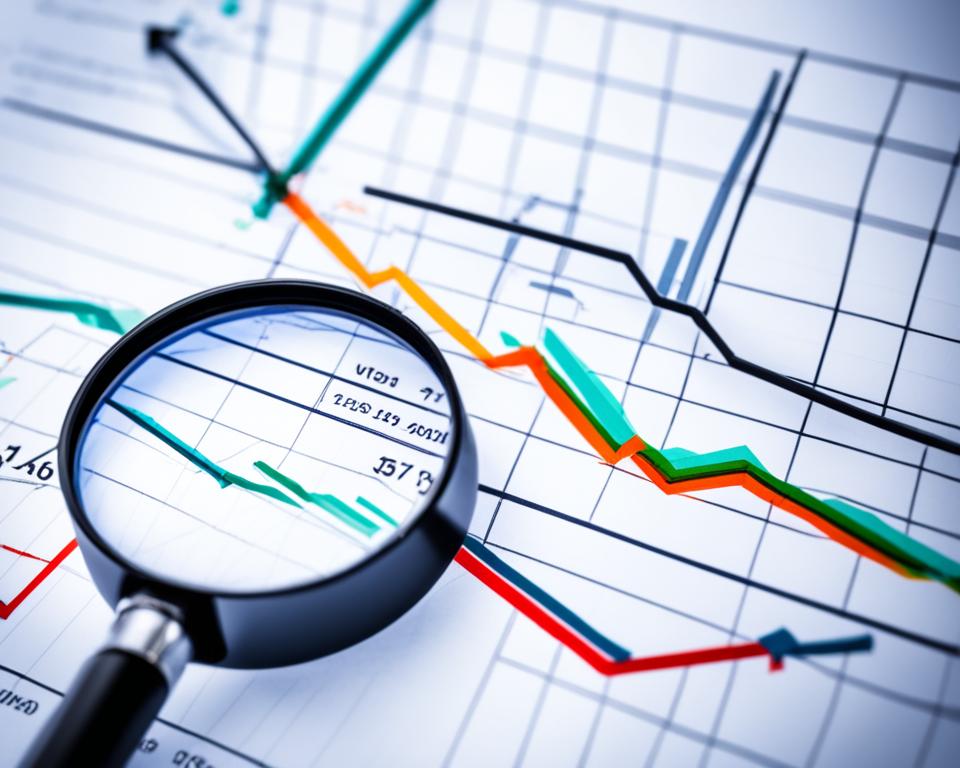
As you navigate the complexities of the investment landscape, remember that past performance is a vital clue but not a definitive guide. Market conditions are unpredictable, and their influence on a company’s dividends is a puzzle you, as an investor, must continually solve. By staying informed and flexible in your approach, you can ensure that your investment strategy remains robust, regardless of the economic climate. Thus, the art of discerning and responding to the nuances of dividend growth becomes a valuable skill in your investment toolkit.
Recognizing Healthy Dividend Growth Rates
As you evaluate your investment opportunities, healthy dividend growth rates may serve as a harbinger of a company’s robust financial future. Discerning what constitutes a strong dividend growth pace will not only guide your portfolio towards sustained earnings but will also fortify your market position against unforeseen fluctuations.
A compound annual growth rate (CAGR) of approximately 5% over a 10-year period is commonly embraced as a benchmark for reasonable growth expectations. Yet, it’s important to remember that dividend growth is not a one-size-fits-all indicator. Different industries will exhibit varying capacities for growth based on their inherent market characteristics and economic cycles.
Comparing Growth Rates Across Industries
When scouring the market for prospective stocks, it’s critical to compare dividend growth rates within industry-specific contexts. What is considered a strong growth rate in the utility sector may not hold the same weight in the technology sector, where reinvestment often trumps payout. Here’s how you might weigh these rates across different industries:
| Industry | 5-Year Avg. Dividend Growth Rate | Industry Standard |
|---|---|---|
| Utilities | 4% | Stable |
| Technology | 10% | Rapid |
| Consumer Goods | 7% | Moderate |
| Healthcare | 5% | Consistent |
Assessing these industry benchmarks against a company’s reported growth rates can position you to make deft decisions that align with reasonable growth expectations.
Setting Expectations for Reasonable Growth
Setting tailor-fit expectations for dividend growth is just as important as recognizing the qualitative health indicators of a dividend’s progression. Realistic projections account not just for the past performance but also for broader economic signals that may sway the natural course of dividends. By establishing industry-adjusted baselines for reasonable growth expectations, your investment strategy acquires a nuance, adjusting to the tempo of market dynamics with agility and insight.
Kneading these factors into your investment plan molds a diversified and resilient portfolio, one that is cushioned against the shockwaves of market volatility. It’s this synthesis of cross-industry knowledge and prudent foresight that defines the successful investor’s journey in harnessing the potential of dividend growth.
Distinguishing Between Dividend Yield and Dividend Growth
When it comes to successful investment strategies, understanding the nuanced differences between dividend yield and high dividend growth is crucial. Dividend yield provides a snapshot of the income your investments are currently generating, while dividend growth offers a glimpse into the future potential of your stocks. Both concepts are integral to a well-rounded investment strategy, particularly when you’re positioned for long-term success in the market. Emphasizing these metrics could mean the difference between average returns and a portfolio that outperforms expectations.
The Implications of High Yield vs. High Growth
The immediate allure of dividend yield is the promise of immediate return on investment; a higher yield indicates more money flowing into your account in the short term. However, a strategy focused solely on dividend yield might miss out on the burgeoning rewards of stocks characterized by high dividend growth. Companies that consistently increase their dividends may have strong fundamentals, suggesting an optimistic forecast for ongoing profitability and stock price appreciation.
Strategizing Investment Choices Based on Dividend Metrics
Your investment endeavors could be significantly shaped by how you interpret and act on dividend yield and growth rates. A lower initial yield might be tolerable if accompanied by high dividend growth, potentially leading to greater wealth accumulation over time. Conversely, a high-yielding stock might be attractive for immediate income needs or if growth opportunities are limited. Ultimately, an effective investment strategy encompasses a balance, weighing each stock’s current yield against its ability to increase dividend payments over time.
| Stock | Initial Dividend Yield | 5-Year Dividend Growth Rate | Potential Influence on Portfolio |
|---|---|---|---|
| Stock A | 4% | 2% | Steady income, low growth |
| Stock B | 2% | 8% | Lower initial income, high growth potential |
| Stock C | 3% | 5% | Balanced income and growth |
Recognizing the potential of a stock is not just about its present yield but also its capacity for dividend expansion. Your portfolio’s strength lies in combining these insights to capitalize on both immediate returns and future growth prospects. By differentiating between dividend yield and high dividend growth, you can tactically steer your investments toward a financial strategy that aims for both security and growth.
Navigating Dividend Growth in the Context of Equity Valuation
Grasping the complexities of dividend growth is integral to equity valuation—a concept central to making informed investment decisions. As a proactive investor, understanding how dividends influence stock prices and the ability to discern their growth patterns become part of your financial acumen. Within this landscape, dividend-centric valuation models offer a way to quantify the impact of dividend behaviors on investment choices.
Understanding the Dividend Discount Model (DDM)
The dividend discount model (DDM) is a cornerstone of equity valuation, tying a stock’s price to the present value of all anticipated future dividend payments. By discounting these predicted dividends back to their present value, the DDM offers investors an estimate of what a stock should be worth today. However, the crux of this model—the expected dividend growth—anchors heavily on a range of assumptions. These include a company’s financial projections, industry trends, and broader economic indicators that could sway future payouts.
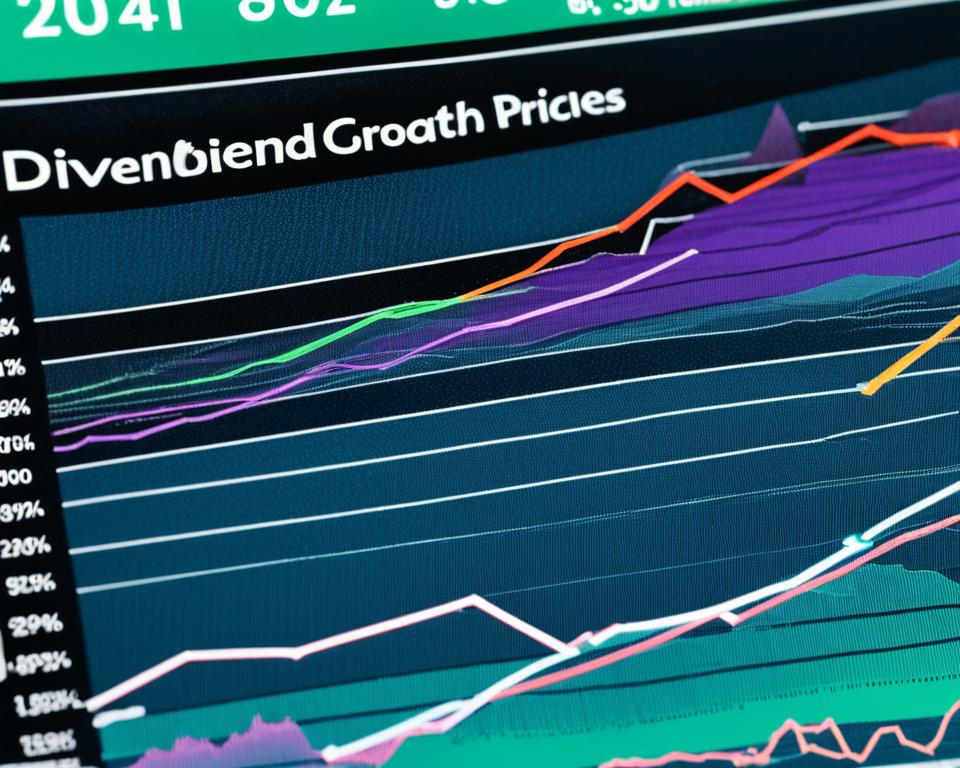
Dividend Growth’s Impact on Estimated Stock Prices
Dividend growth patterns are more than historical data; they embody potential future outcomes with direct implications on stock valuations. The narrative suggested by a consistent rise in dividends often leads to increased stock prices, as such stocks are perceived by investors as more valuable due to their robust financial standing and promising future prospects. Adversely, uncertainties or slowdowns in dividend growth can affect stock prices, causing reevaluation of the intrinsic value and potential reconsideration of the stock’s role in investment portfolios.
By integrating the dividend discount model into your investment strategy, you can balance the risks and opportunities inherent in the stock market. Remember that adopting a margin of safety—buying stocks at a price well below their calculated intrinsic value—can provide some insurance against the impact of stock prices dropping, dividend cuts, or unexpected market turns. Such strategic planning is crucial as you navigate the multifaceted world of equity valuation, dividend growth, and their collective impact on stock prices.
Dividend Trends and the Impacts of Global Economic Events
The landscape of dividends can be significantly reshaped by global economic events, and as an investor, your savvy lies in adapting to these fluctuations. Recognizing the delicate ties between market movements and dividend predictions is a testament to a robust investment approach. Let’s look at a real-world scenario that illustrates just how profound the global economic events impact can be on dividend strategies and what it means for adjusting dividend growth expectations.
The COVID-19 Pandemic as a Case Study
The COVID-19 pandemic served as an unequivocal stress test for the financial resilience of companies worldwide. Many corporations, faced with unprecedented conditions, were forced to reconsider and amend their dividend policies. For example, Wells Fargo, a prominent financial institution, opted to slash its dividend as a countermeasure to the prevailing economic hardship and regulatory pressure. This decision underscored the vulnerability of dividends to sudden and severe market turbulence.
Conversely, Coca-Cola showcased its financial sturdiness by maintaining its dividend, reassuring investors of its ability to withstand the economic downturn. This divergence in corporate responses emphasizes the critical need for investors to evaluate the robustness of a company’s dividend policy while considering the potential for sharp turns in the economic landscape.
Adjusting Dividend Growth Expectations Post-Crisis
In the aftermath of such sizable disruptions like the pandemic, it’s essential to recalibrate your dividend growth projections. Adjusting your expectations isn’t about pessimism; it’s about pragmatic anticipation of adjusting dividend growth expectations in a changed world. An event of this scale can reverberate through industries, forcing companies to reinvent their approaches to capital allocation and dividend payments.
As you navigate post-crisis waters, it’s prudent to construct your dividend-based investment strategies with flexibility in mind. Consider the broader impacts of economic downturns, such as reduced corporate earnings and revised dividend policies, and how they would alter your growth expectations. Keeping a keen eye on a company’s historical and anticipated ability to handle economic shocks will fortify your investment decisions, ensuring a portfolio that’s equipped for resilience.
Incorporating Dividend Growth into Portfolio Diversification
Embracing portfolio diversification is a fundamental ethos for any investor aiming to build a resilient and prosperous financial future. In the elegant dance of the stock market, diversification is the rhythm that buffers you against volatility and secures your path towards long-term growth. However, true diversification extends beyond spreading your bets across different sectors or asset classes—it also means balancing your portfolio with a mix of high-growth prospects and steady, reliable dividend payers.
Balancing High Growth and Steady Dividend Payers
The astuteness of a strategy blending high-growth stocks with steady dividend payers cannot be overstated. While high-growth companies promise the allure of substantial capital appreciation, they often come with higher volatility and risk. Balancing these with steady dividend payers provides a cushion of regular income, creating a harmonious interplay between potential gains and security in your investment symphony.
The Role of Dividend Kings and Dividend Aristocrats
Among the elite class of dividend payers, Dividend Kings and Dividend Aristocrats stand as towering beacons of consistent shareholder returns. These are not merely titles but hallmarks of companies that have achieved the remarkable feat of increasing dividends annually for at least 50 and 25 consecutive years, respectively. Looking to fortify your portfolio’s ramparts with unyielding streams of income? Then turning to these sentinels of dividend growth might be a move most shrewd.
Dividend Kings and Aristocrats earn their crowns and thrones through an unwavering commitment to returning value, a testament to their operational fortitude even when economic tempests rage. By allocating a portion of your portfolio towards these venerable entities, you ensure that your investment bolsters are not merely robust but are infused with the might of financial sovereignty that has stood the test of time.
Remember, as you weave your tapestry of investments, incorporating longevity, stability, and growth driven by dividends lifts your financial design into the stratosphere of savvy investing. As the journey of a thousand miles begins with the first step, let Dividend Kings and Aristocrats be your steadfast companions on the road to diversified success.
Implementing Margin of Safety in Dividend Growth Investing
Amid the pursuit of dividend growth investments, savvy investors always include a pivotal component in their strategy—the margin of safety. This concept is instrumental in building an investment portfolio grounded in prudent financial principles and focused on investment security. By setting prices below the values determined by various valuation models, you’re not just protecting your investments from downside risk, but you’re also positioning your portfolio for sustainable growth.
Setting Conservative Growth Assumptions
One of the key tenets of applying a margin of safety is establishing conservative growth assumptions. Overestimating a company’s ability to grow its dividends can lead to inflated stock valuations and disappointing returns. Your defense against such pitfalls? Exercise caution by tempering growth expectations and anchoring your decisions in a foundation of conservatism, ensuring that your growth predictions remain grounded and realistically attainable.
Ensuring Long-term Investment Security
In the long game of investing, investment security is synonymous with sound sleep. By insisting on a margin of safety, and thereby, purchasing shares at a discount to their intrinsic value, you create a cushion against market volatility and economic downturns. Think of it as building a financial moat around your portfolio, securing it against the vagaries of the market and ensuring that the growth trajectory of your dividends is not just a hope but a probability.
Consider the dividend discount model (DDM), which calculates the present value of expected future dividends. A stock might appear enticing at first glance, but without applying a margin of safety, the investment could be precarious. Demanding that a stock’s price be significantly lower than the DDM value before buying, you weave a stronger safety net, increasing the chances of your investments outperforming in the long run.
To exemplify the importance of setting conservative growth assumptions and how they enhance investment security, let’s review the following DDM table of a hypothetical stock:
| Dividend Forecasted | Discounted Value (With Conservative Growth) | Market Price | Margin of Safety Applied | Investment Decision |
|---|---|---|---|---|
| $2.00 | $30.00 | $40.00 | No | Overpriced, Do not buy |
| $2.00 | $30.00 | $24.00 | Yes | Undervalued, Potential buy |
| $2.00 | $30.00 | $35.00 | Minimal | Priced appropriately, use discretion |
Your expertise in distinguishing the fine line between potential and peril lies in these strategic applications of conservative estimations and steadfast insistence on the margin of safety. As you continue to navigate the thrilling world of dividend growth investing, let these principles be your guide, leading you towards thriving investment horizons with substiantial investment security.
Expanding Beyond the Dividend: Total Return Considerations
While dividends are often the highlight for income-focused investors, a broader perspective is necessary to truly understand the value of an investment. It’s not just about the immediate cash flow from dividends, but also the total return which includes the potential for capital appreciation. This total picture of returns extends your strategy beyond the horizon of immediate income to the full spectrum of financial growth opportunities.
Factoring in Capital Appreciation Alongside Dividend Income
Many investors are drawn to the allure of dividend payments, using them as a measure of a stock’s value. However, savvy investors know that capital appreciation is equally important in the calculation of total return. As stock prices increase over time, the gains you accumulate through this appreciation can significantly boost the overall performance of your investment, sometimes even surpassing the income generated from dividends. It’s this combination of dividend yield and price appreciation that offers you the truest sense of a stock’s worth.
Comparing Dividend Growth and Retained Earnings Reinvestment
Dividend growth is undoubtedly a sign of a company’s financial health and shareholder-centric approach. However, understanding the role of retained earnings reinvestment is also critical. When companies opt to reinvest their profits, they can finance expansion, innovate, or improve operational efficiencies. Over time, these investments can lead to capital appreciation of stocks, thereby enhancing the total return to shareholders. This perspective is essential when comparing companies that pay high dividends with those that retain more earnings for reinvestment and potential capital gains.
The art of investing demands that you take into account all avenues leading to wealth generation, from dividends to the compounded benefits of reinvestment. Whether through steady dividend payouts or strategic retention of earnings for reinvestment purposes, both strategies have the potential to bear fruit in the form of total return. Recognizing that dividends are not the sole driver of investment value, but part of a larger picture, you can make more informed and holistic investment decisions aimed at optimizing long-term growth.
Conclusion
Mastering the interpretation of dividend growth is not just beneficial; it’s a strategic maneuver that sharpens your financial acumen and empowers your portfolio. The journey through stock market landscapes is punctuated by the insights gained from interpreting long-term dividend trends, and it’s through these valuable revelations that you can pave the pathway to sustained financial prosperity.
Consolidating Dividend Growth Interpretation into Investment Strategy
You now know that the dividends a company issues are far from random; they are intentional signposts that help steer strategic investment decisions. By embedding the understanding of dividend trends into the core of your investment strategy, you become equipped to uncover the intrinsic value of stocks, utilizing dividend discount models as detailed maps to stock valuation treasures. Nevertheless, the prudence of incorporating a margin of safety into your investment convictions cannot be overstated. This approach cushions your assets against market volatility, reinforcing the resiliency of your financial endeavors.
Embracing the Predictive Power of Dividend Trends
Recognizing and interpreting long-term dividend trends transforms them into powerful tools for forecasting a company’s fiscal journey. While dividends are influenced by the shifting sands of global economic events, their historical performance and current growth patterns can offer a predictive glance into a stock’s future. The commitment to diversify your investments, and the vigilant observation of dividend progressions, will serve as the bulwark of your portfolio—assuring that even amid economic storms, your investment choices remain anchored and yield fruitful returns. Your mindful navigation through these aspects ensures that the dividends of today illuminate the profits of tomorrow.
FAQ
How can investors interpret dividend growth trends and patterns?
Investors can interpret dividend growth trends by analyzing historical dividend data and using it to project future trends. By examining year-over-year increases and assessing whether these increases are linear or geometric, investors can gauge the long-term profitability and health of a company. This analysis can inform decisions on stock valuation and potential investments.
Why is the dividend growth rate important for stock valuation?
The dividend growth rate is fundamental in applying stock valuation models like the dividend discount model (DDM), which determines the intrinsic value of a stock based on anticipated future dividend payments and growth. A higher dividend growth rate can suggest a company’s increasing profitability and the likelihood of receiving larger dividend payments in the future, which can make the stock more valuable.
What constitutes a dividend, and why do they matter to investors?
A dividend is a payment made by a company to its shareholders, typically from its profits. Dividends provide shareholders with a regular income stream and can be a sign of a company’s financial health. They are a critical component of the total returns of an investment, offering benefits during both up and down markets.
How do historical dividend data contribute to forecasting future trends?
Historical dividend data can reveal patterns in how a company has grown its dividends over time. Trends such as consistent increases can indicate a company’s commitment to returning value to shareholders and can help investors estimate future cash flow for dividend payments, which is essential in valuing stocks and making informed investment decisions.
What is the difference between linear and geometric dividend growth calculations?
Linear dividend growth calculations look at the simple year-over-year growth in dividends, which can be useful for short-term analysis. Geometric growth calculations, on the other hand, consider the compounded annual growth rate (CAGR), providing a more accurate reflection of long-term growth as it takes into account the effect of compounding.
How can investors assess the sustainability of a company’s dividend growth?
Investors can assess dividend sustainability by looking at a range of factors such as the company’s payout ratio, earnings stability, free cash flow, and historical trends of dividend payments. A sustainable dividend is typically supported by consistent earnings and a reasonable payout ratio that leaves room for future growth.
What factors can affect dividend stability in various market conditions?
Dividend stability can be influenced by economic downturns, regulatory changes, competitive industry shifts, and global events like pandemics. These factors can affect a company’s profitability and cash flow, which in turn can impact its ability to maintain and grow dividends.
How do growth rates across industries impact investor expectations?
Different industries have varying potentials for growth, which can affect expected dividend growth rates. For example, technology companies may have higher growth rates due to rapid innovation, while utilities might offer slower, more stable growth. Investors need to compare growth rates within the same industry to set reasonable and realistic expectations.
What is the implication of high yield versus high dividend growth for investors?
High yield indicates a higher income return relative to the stock price, which may appeal to income-focused investors. High dividend growth suggests that a company’s dividend payouts are likely to increase over time, which can be attractive for those looking for growth in their portfolio. Investors might seek a balance based on their investment goals and risk tolerance.
How does the dividend discount model (DDM) incorporate dividend growth?
The DDM incorporates dividend growth by discounting expected future dividends back to their present value, which requires an assumption about the growth rate of these dividends. A higher expected growth rate will increase the calculated intrinsic value of a stock, while a lower growth rate will decrease it.
How have global economic events, such as the COVID-19 pandemic, affected dividend trends?
Global economic events can disrupt company operations and, as a result, impact dividend policies. During the COVID-19 pandemic, many companies reevaluated or reduced their dividends to preserve capital. Such events underscore the importance of being flexible in dividend growth expectations and investment strategies.
Why is portfolio diversification important in dividend growth investing?
Diversification is key in managing risk and ensuring a balanced investment approach. Combining stocks with high dividend growth potential and those with steady dividend payments can offer a mix of growth and income, providing a buffer against market volatility and enhancing overall portfolio performance.
What does incorporating a margin of safety in dividend growth investing entail?
Incorporating a margin of safety means making conservative estimates about future dividend growth and ensuring that investment decisions include a buffer in case of lower-than-expected dividend increases. This approach protects against the possibility of overpaying for a stock based on overly optimistic dividend growth projections.
How should investors factor in total return when considering dividend growth?
Total return incorporates both the income from dividends and capital appreciation of the stock. Investors should consider how dividend growth can contribute to the total return, but also keep in mind the effect of earnings reinvestment and other company growth strategies that may not involve dividends.
How can investors leverage the predictive power of dividend trends in their investment strategy?
By analyzing historical dividend trends and growth rates, investors can make educated assumptions about a company’s future financial performance. This knowledge, combined with current market analysis and a prudent consideration of risk, can help investors develop a more robust and resilient investment strategy.

